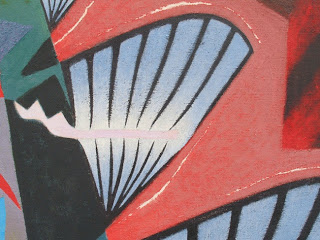www.artandmusicvenues.blogspot.com
Calder Shadows cast a new venue of the artist’s mobiles and stabiles in an exhibition that dramatizes kinetic shadow impressions in a group of rare Calder works. Showcased in darkness---the ‘Venus Over Manhattan gallery in New York invites you to step into the expansive dark gallery, where each of Calder’s sculptures, created between 1929 and 1974, are lit so that its shadows become the exhibition’s subject.
WHIM OF THE LIGHT Dancing on the walls and moving at the whim of a light breeze or gently prodded the shadows cast on the walls, ceiling, and floor of the gallery provide a fascinating interpretation of the metal forms on display. Ever changing the wire versions become oscillating line drawings and flat metal forms become independent presences. The fascinating shadows captivate attention as the shadows seemingly change position and present an entirely different view of the object. Case in point: A mobile does not stand still and as it gently moves a new perspective of the work emerges as a different shadow version on the wall.
CALDER'S OEUVRE Calder’s mechanized works gave way to his mobiles and stabiles, sculptures that disparate metal elements, made from bent wire and flat sheet metal cut-outs were constructed with such masterful equipoise that their movements occur naturally and unpredictably in response to the energy of surrounding atmosphere.
INSPIRATION After visiting Piet Mondrian’s studio in 1930, Calder began the experiments with abstract construction that would come to define his oeuvre. He drew inspiration from the playful work of Joan Miro and Paul Klee, making hand cranked and motorized kinetic sculptures that challenged the definition of a sculpture as a form fixed in time and space.
CALDER REMEMBERED As a student in the mid-1920s, the man who would become the celebrated sculptor, painter, illustrator, printmaker and designer, worked for the National Police Gazette newspaper and was assigned to sketch the Ringling Brothers and Barnum & Bailey Circus. One of the artist’s most enduring beloved works, first fashioned in 1926, is his Cirque Calder; a miniature circus made from wire, string, rubber and found materials, which today resides in the Whitney Museum of Art in New York. Today his works can be seen in other prestigious museum collections.
Alexander Calder (1898-1976), the renowned American artist, was born in Philadelphia, Pennsylvania and died in New York City, which often proclaims him as their own native son.
VENUS OVER MANHATTAN is located at 980 Madison Avenue, between 76th and
77th streets, on the third floor and is open to the public Tuesday through Saturday
from 10 am-6pm. Additional info contact: info@andreaschwan.com
Polly Guerin author: The Cooper-Hewitt Dynasty of New York (History Press 2012)












Add a comment